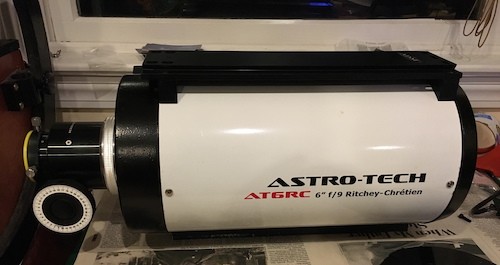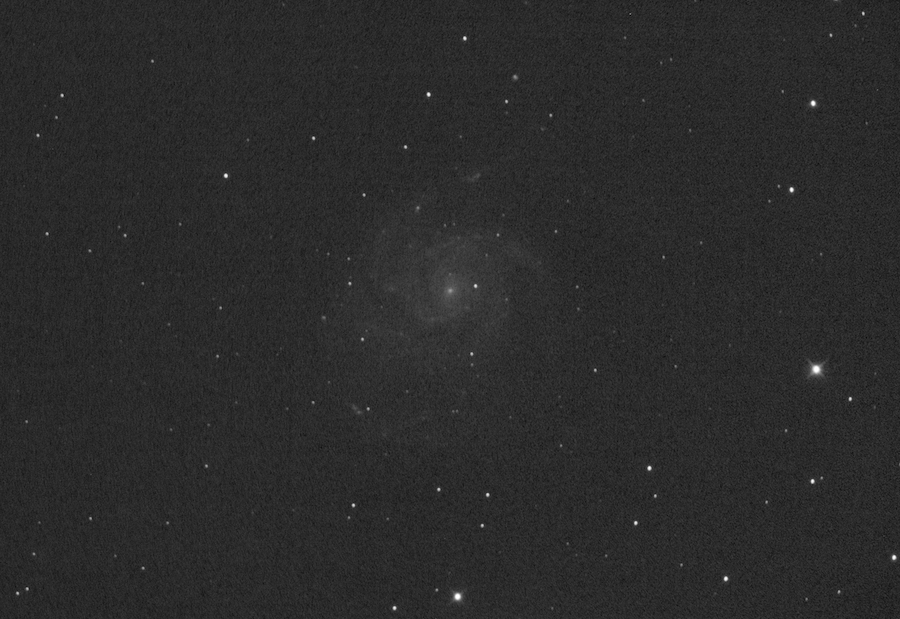
Optics
The Apertura 6” Ritchey-Chrétien is a 6” (152mm) f/9 Ritchey-Chrétien telescope with a focal length of 1370mm. Ritchey-Chrétien telescopes, essentially a variant of the Cassegrain, have been popular among professionals for over a century, with the design being used in telescopes such as the European Southern Observatory’s Very Large Telescope and the Hubble Space Telescope. The reason for their popularity is the sharp and mostly flat field of view produced by the combination of hyperbolic concave primary and convex secondary mirrors. There is no coma like there can be with a Cassegrain, Dall-Kirkham, Newtonian, or SCT, and it’s easier to achieve a flat field at faster focal ratios than with other Cassegrain-derived optical designs. However, it’s worth noting that the edges of the field of view with a Ritchey-Chrétien are not completely flat, and you may want to use a field flattener for larger camera sensors, much like with a refractor, though smaller sensors won’t require one. The scope cannot illuminate a very large sensor chip without vignetting; an APS-C-sized sensor is best.
The Apertura 6” Ritchey-Chrétien’s secondary mirror is held by a spider, like a Newtonian reflector. As such, you will get diffraction spikes in your images like a Newtonian. This is something to consider when choosing between this telescope and a refractor or Schmidt-Cassegrain design that will not produce spikes. The central obstruction by the secondary mirror is also gigantic, at 47% of the diameter of the primary mirror, which will provide noticeably lower contrast on high-resolution targets if you use this telescope visually or for planetary imaging. As such, it is not particularly recommended for either purpose.
Mechanics
The focuser attached to the back of the Apertura 6” Ritchey-Chrétien is a standard GSO 2” dual-speed Crayford focuser, which has 34mm of travel. It works alright for imaging use, but it can slip under heavy loads, and even the tiniest amount of tilt severely affects sharpness with the Ritchey-Chrétien design. The built-in rotating collect allows you to spin your camera for ideal framing, but adds additional possibilities for tilt issues. As such, you may want to replace it with an aftermarket unit from another manufacturer. To provide additional focus travel, the scope includes three focuser extension rings to accommodate a variety of back-focus applications. For use with a typical DSLR camera, you’ll need to use the 1″ and 2″ extension tubes. Despite its flaws, the 2” Crayford focuser lacks the image shift or mirror flop issues found in the internal focusing system of most Schmidt-Cassegrains, making it an arguably superior choice.
Collimating the Apertura 6” Ritchey-Chrétien is done by adjusting screws behind the primary mirror as well as the secondary mirror. These are not spring-loaded; you have to tighten the opposing pair of screws when you loosen one, and vice versa. The screws have to be very tight and are adjusted with a hex key. Collimation is extremely critical for achieving sharp images and will require either a high-quality laser collimator or using the star test (our telescope collimation guide explains how) with an eyepiece. This can be extremely frustrating and difficult to do. The good news is that if you tighten the screws sufficiently, you should not have to adjust the collimation of the telescope frequently or ever again.
The Apertura 6″ Ritchey-Chrétien comes with a standard Vixen/Synta-style finder scope base on the side of the tube and threaded holes for adding another finder/guide scope base on the opposite side. To attach to a suitable equatorial mount, Apertura provides a Vixen-style dovetail bar with the 6” Ritchey-Chrétien. You can replace it with a larger Losmandy D-style dovetail for a more rigid connection, as well as re-locate the Vixen plate or add another dovetail to the top of the tube for mounting accessories such as a guide scope, though we’d recommend an off-axis guider if you are worried about focuser tilt.
Mount Recommendations
The Apertura 6” Ritchey-Chrétien can be used on a Sky-Watcher HEQ5i Pro or similar size mount with good autoguiding, though you may have to throw out some frames. At 1370mm focal length, accurate tracking and guiding are critical. A larger mount like the Sky-Watcher EQ6Ri Pro or Celestron CGX is ideal.
Should I buy a Used Apertura 6” Ritchey-Chrétien?
A used Apertura 6” Ritchey-Chrétien or identical model from another manufacturer can be a great scope, though it’s possible the seller may have messed up the collimation, which can be a pain to fix. You should make sure that the mirror coatings are clean and bright, free of corrosion or other damage. Otherwise, there’s fairly little that can go wrong.
Alternative Recommendations
The Apertura 6” Ritchey-Chrétien is a nice scope for imaging, but you may also want to consider a few other optical tubes for the job:
- The Celestron C6 XLT can be used with an f/6.3 reducer or f/2 HyperStar conversion for a faster f/ratio than the Apertura 6” Ritchey-Chrétien and is vastly superior for planetary imaging and visual observation. However, its focus system can have image shift and it is not ideal for use at f/10 for imaging galaxies.
- The Sky-Watcher Quattro 6″ F/4 Imaging Newtonian OTA offers a much more forgiving focal ratio and focal length than the 6” Ritchey-Chrétien, along with a wider field and nice views at the eyepiece.
- The Sharpstar 76EDPH is our top pick in the price range of the Apertura 6” Ritchey-Chrétien for beginner astrophotographers due to its simplicity and lax mounting/guiding requirements. It is not really comparable in capabilities, however.
- The Celestron C8 EdgeHD offers fantastic performance for imaging at f/7 or f/2 with a reducer/HyperStar, the former achieving a similar focal length to the Apertura 6” Ritchey-Chrétien, and is also great for visual observation and planetary imaging. However, it has essentially the same stringent mounting requirements as the 6” Ritchey-Chrétien for long-exposure astrophotography.
Aftermarket Accessory Recommendations
If you want to use the Apertura 6” Ritchey-Chrétien with a separate guide scope, it’s best if you have a guide scope at least 50mm in aperture, and attach it via a dovetail rail bolted to the top of the main optical tube. The dovetail rail, which can be either Losmandy-style or Vixen-style, helps to keep the center of gravity of the guide scope aligned with the mount to minimize additional strain and torque on your mount. An off-axis guider will provide better results than a guide scope but can be harder to set up and reach focus with the telescope.
The ZWO ASI224MC or another camera like it is required as a guide camera for the Apertura 6” Ritchey-Chrétien, and these are great cameras for planetary imaging too. As such, despite the scope’s less-than-ideal optical configuration for planetary work, it doesn’t take much else besides a Barlow lens to also use it for planetary imaging, and it will be far superior to a small refractor for the task.
A Bahtinov focusing mask is an extremely useful astrophotography accessory for the Apertura 6” Ritchey-Chrétien or any telescope. You may also want to consider investing in a motor focuser such as the ZWO EAF or Pegasus motor focuser, and/or replacing the stock Crayford focuser with a unit from Moonlite or Feathertouch.
For visual observation, you’ll want to obtain a finder scope, eyepieces, a suitable star diagonal, and other accessories such as nebula filters for the Apertura 6” Ritchey-Chrétien, though as we’ve mentioned, it is neither the most economical nor the sharpest option for the job out there.
Astrophotography Capabilities
When paired with a suitable equatorial mount and guiding setup, the Apertura 6” Ritchey-Chrétien is a great telescope for imaging most galaxies, and you’ll get much better sampling and image scale than with a smaller refractor or fast Newtonian astrograph. Planetary images with a Barlow lens and high-speed camera will seem “soft” compared to a comparable SCT or Maksutov, but will beat a small refractor or a heavily barlowed fast Newtonian telescope.
What can you see?

Despite being less-than-ideal for the job, the Apertura 6” Ritchey-Chrétien can still provide nice views at the eyepiece, allowing for a maximum true field of about 1.8 degrees without vignetting. Light-gathering is reduced by the giant secondary mirror, however, so the image brightness isn’t going to be much better than that of a 5” telescope of most other optical configurations, and the huge central obstruction “softens” planetary views to be more in line with those of a 4.5” or 5” telescope. However, you can still resolve the phases of Mercury and Venus, spot the ice caps and dark markings on Mars, resolve tons of detail on the Moon, and see the Galilean moons of Jupiter as disks, along with the Great Red Spot. The Cassini Division in Saturn’s rings can be resolved along with the planet’s cloud bands and moons, and you can tell Uranus is a disk or observe Neptune’s moon Triton. Open star clusters dazzle, the brightest globular clusters can be partially resolved into individual stars, and you can see dust lanes in many of the brighter and more easily observed galaxies if you have sufficiently dark skies. You can also see planetary nebulae and prominent emission nebulae like Orion (M42) or the Lagoon (M8), and split thousands of colorful double stars.


